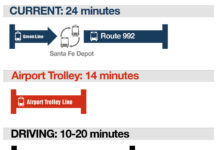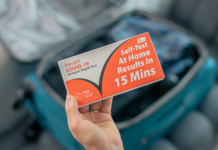By Emily Cottrell & Brian Gruters
Dear Clairemont Community Planning Group:
(Note: this letter was originally sent and read live to the Clairemont Community Planning Group at their May 15th monthly meeting and is being reprinted with permission)
We are writing to you as Clairemont residents, employees of local businesses, and neighbors of the Mt. Alifan supportive housing project. We wish to express our support for this proposed development because we believe that using a Housing First approach and supportive housing to address homelessness in San Diego is good government and the right thing for Clairemont.
Housing First is an evidence-based approach to helping people out of homelessness by focusing on their most critical need first, which is finding a home. People have more success dealing with issues related to disabilities, finances, or even addiction, when they aren’t living on the street. In San Diego, most housing and services dedicated to homelessness use a Housing First approach because it has proven more effective over time, and most federal, state, and local funding sources require it.
Studies have shown that using a Housing First approach to pairing subsidized housing with supportive services such as case management is a highly effective way to help individuals experiencing long term homelessness move into and remain in a home.[1] It is also extremely cost effective. [2] Neither San Diego nor Clairemont can afford to ignore the data supporting this model.
We understand that some of our neighbors have questions and concerns about this project, and we agree that they deserve answers. Yet, much of the information provided by people opposing the Mt. Alifan Project appears to be exaggerated, or flat out wrong, and seems to be playing on people’s fears. For example, the claim that this project will include “the worst of the worst out of all different communities of San Diego”[3] is not only inappropriate, but also overstated.
It’s true that if the property is dedicated to serving San Diegans experiencing homelessness, applicants would likely be individuals with a variety of disabling conditions. And it’s true that this might include addiction to alcohol or drugs. It’s also true, however, that a person could qualify for having a chronic health issue, such as diabetes or heart disease. Individuals would most likely be selected through the regional Coordinated Entry System (CES) database, another evidence-based practice, which prioritizes people based on their level of need. This takes into account a variety of factors, including age, time spent on the street, and a person’s medical background.
People in opposition often reference existing public safety issues surrounding the Mt. Alifan Project, however we see these as unrelated. Reliable studies have shown that supportive housing has a neutral effect on safety in neighborhoods, and in some cases, may even increase it.[4]
We recognize that our neighbors are concerned about the character of the neighborhood and the impact of this project on housing values. We are also property owners in the neighborhood, and we do not share these concerns. Studies show that long-term supportive housing is beneficial to surrounding communities. One of the most comprehensive studies to date shows that new supportive housing developments increased property values in the neighborhoods where they were built. [5]
Over the next several months we hope that misconceptions and truly valid concerns around this issue can be resolved. We invite any concerned neighbors to reach out to us for more information or to discuss why we think this development will benefit the Clairemont community. Ultimately, we want to engage in reasonable discussions that allow for consensus rather than division and opposition.
The Clairemont Community Planning Group will serve as a voice of the community to City Hall. We urge this group to recognize that the voice of groups in opposition is not the only voice in the community. When and if the Planning Group must make recommendations to the City Council, the Planning Commission, City staff, or others regarding approval of the Mt. Alifan Project, please take into consideration all perspectives on development of supportive housing in Clairemont, particularly in light of the City’s long-range goals of alleviating homelessness and avoiding another public health crisis.
Many Clairemont residents truly want to be part of the solution. Clairemont is the heart of San Diego, and the Mt. Alifan Project would be located in the heart of Clairemont. We would welcome our new neighbors just like all others, and hope to see them find comfort in their new homes here.
Please feel free to contact us via email at clairemonthousingfirst@gmail.com. Thank you for your consideration and for your service to our community.
[1] S. Tsemberis & R. Eisenberg, Pathways to Housing: Supported Housing for Street-Dwelling Homeless Individuals with Psychiatric Disabilities. 2000. https://ps.psychiatryonline.org/doi/pdf/10.1176/appi.ps.51.4.487
[2] National Alliance to End Homelessness, Supportive Housing is Cost Effective. January 2007; K. Snyder, Ending Homelessness Today. June 30, 2015. https://endhomelessness.org/study-data-show-that-housing-chronicallyhomeless-people-saves-money-lives/
[3] https://www.nbcsandiego.com/news/local/Clairemont-Puts-Up-Fight-Against-Apartment-Complex-Homeless481570981.html
[4] See Arch City Development’s National Church Residences Permanent Supportive Housing Impact Analysis. Available: https://shnny.org/uploads/Columbus-NIMBY-Study-2013.pdf
[5] For example, see Furman Center for Real Estate and Urban Policy, The Impact of Supportive Housing on Surrounding Neighborhoods: Evidence from New York City. 2008. Available: https://furmancenter.org/files/FurmanCenterPolicyBriefonSupportiveHousing_LowRes.pdf.



